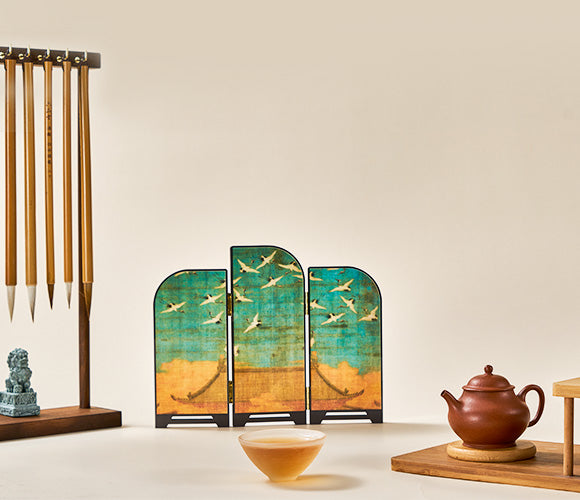Tea is an essential part of Chinese culture, and tea ceremony, the art of brewing and enjoying tea, is not just about drinking; it’s about appreciating the whole experience. Whether you're a complete beginner or already have some knowledge of tea, learning the proper brewing methods and techniques will enrich your tea-drinking journey.
This beginner’s guide will provide you with simple and easy-to-follow steps, helping you understand everything from water temperature to the right tea-to-water ratio, so you can easily start your journey into the world of Chinese tea ceremony.
1. Choose the Right Tea
China offers a wide variety of tea, each with its unique flavor and brewing requirements. As a beginner, you can start with the following types of tea:
Green Tea: Light and fresh, with herbal or floral notes, perfect for morning or afternoon tea. Examples include Dragon Well and Bi Luo Chun.
Black Tea: Richer in flavor, with a sweet, malty aroma. Darjeeling and Keemun are great choices.
White Tea: Mild and subtly sweet, suitable for any occasion with a delicate taste.
Pu-erh Tea: Deep and earthy, perfect for those who enjoy a strong, aged flavor.
Choosing the tea that suits your taste is the first step. Different teas have varying requirements for water temperature and steeping time, so understanding these basics will help you get the best flavor from your tea.
2. Master the Correct Water Temperature
Water temperature is crucial in brewing tea. Each type of tea has a specific temperature range that helps release its best flavors. Here’s a guide:
Green Tea: Generally requires lower water temperatures (around 70°C to 80°C). Too hot, and the tea will taste bitter.
Black Tea: Works best with near-boiling water (90°C to 95°C), allowing the tea’s full aroma to emerge.
White Tea: Use water at around 80°C to preserve its delicate and fresh taste.
Pu-erh Tea: Ripe Pu-erh requires water around 95°C, while raw Pu-erh can be brewed with water closer to boiling (95°C to 100°C).
By using the appropriate water temperature for each tea, you can bring out the full flavors and aromas.
3. Get the Tea-to-Water Ratio Right
The amount of tea leaves you use in relation to the water will also affect the strength and taste of your brew. A general guide for the tea-to-water ratio:
For most green teas, use about 2-3 grams of tea per 200ml of water.
For black tea and Pu-erh, you can use 3-5 grams per 200ml of water.
White tea generally requires less, around 2-3 grams per 200ml of water.
Adjusting the amount of tea allows you to control the strength and flavor of your tea to suit your personal preferences.
4. Know the Correct Steeping Time
Steeping time is another important factor. Brewing for too long can make the tea bitter, while brewing for too short a time may not release enough flavor. Here are some typical brewing times:
Green Tea: Typically 1-2 minutes. Steep too long, and it may taste too bitter.
Black Tea: Recommended steeping time is 3-5 minutes. If steeped too briefly, the tea may taste too weak.
White Tea: Generally 4-6 minutes, as white tea is more delicate and requires a longer steeping time to bring out its flavor.
Pu-erh Tea: Steep for 1-2 minutes for the first infusion, then adjust the time based on taste for subsequent infusions.
By following these steeping times, you can ensure the best flavor without overbrewing.
5. Choose the Right Teaware
The choice of teaware plays a key role in the tea-brewing experience. Different types of teapots and cups help release the best aroma and enhance the tea’s flavor.
Teapot: Glass teapots are great for watching the leaves unfold, while ceramic or Yixing teapots are better for retaining heat, especially with black tea and Pu-erh.
Tea Cups: Choose cups that can retain heat, such as ceramic tea cups, which help preserve the tea’s warmth and highlight its aroma.
Tea Pitcher: A tea pitcher (also called a tea sea) is useful for evenly distributing the tea into cups, ensuring a consistent flavor.
For beginners, starting with simple glass teapots and tea cups is a good choice, as it allows you to easily observe the tea’s color and infusion process.
6. Enjoy the Experience of Each Steep
Tea ceremony is not just about drinking; it’s about appreciating every step of the process. With each infusion, the tea’s color, aroma, and flavor evolve. Pay attention to the color of the tea, smell the fragrance, and savor the taste. This mindful process will help you appreciate the true essence of tea.
As you deepen your knowledge of tea, you’ll realize that each tea variety offers a unique charm. With time and patience, the art of tea will become an enriching part of your life, bringing you relaxation and peace.
Find similar articles:
BlogMore stories

How to Best Steep Aged White Tea?


